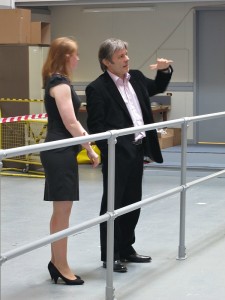 One of the first things which becomes clear upon meeting Bruce Dickinson is his passion for the aviation industry. As an ATPL, Bruce has experience flying for former UK charter airline Astreus, as well as a part in establishing Cardiff Aviation, an MRO based in St Athan. From his own flying – which he says is currently restricted to sim time and a few hours now and again in a Bulldog – right through to his involvement in the MRO, Bruce speaks with enthusiasm on every aspect of a pilot career. The first maintenance and repair job at Cardiff Aviation was completed in November 2012, and now the team is laying plans for flight operations and a training facility. Pilot Career News met with Bruce to find out more…
One of the first things which becomes clear upon meeting Bruce Dickinson is his passion for the aviation industry. As an ATPL, Bruce has experience flying for former UK charter airline Astreus, as well as a part in establishing Cardiff Aviation, an MRO based in St Athan. From his own flying – which he says is currently restricted to sim time and a few hours now and again in a Bulldog – right through to his involvement in the MRO, Bruce speaks with enthusiasm on every aspect of a pilot career. The first maintenance and repair job at Cardiff Aviation was completed in November 2012, and now the team is laying plans for flight operations and a training facility. Pilot Career News met with Bruce to find out more…
Cardiff Aviation has just acquired European Skybus, and with it, a number of sims, including a 747-400. What’s in the immediate future for Cardiff Aviation?
The sims will be moved in September, or so we hope, meaning that Cardiff will have an operational sim, a 747-400, before the end of September 2013. Until mid-September, it’s very much business as usual here (at European Skybus, based at Bournemouth) and in Cardiff. Everything that’s happening is with a view to progressing in the future.
We’re also expecting our AOC (Air Operator Certificate) from the CAA within 60 days, so it’s a very exciting time as we will be relaunching our flight operations. We decided that with all things considered, it wasn’t worth resurrecting Astreus, but we said that the airline would be back, and we will be, a year and a half later and with a new name, Flystar
Can you tell me more about your plans for Flystar and its operations?
Sure, initially we will be starting with a number of aerial routes for surveying and photography. We hope to then expand with a two or three bizjets, say a couple of VLJs and a mid-size, before moving on to one or two regional jets, running European routes. Moving forwards, perhaps we’ll then look towards Airbus and Boeing. You never know…
Alongside an airline comes the idea of an ATO, so one of the next projects will be the approval for a pilot training facility in Cardiff.

The 747-400 simulator which will make the journey from Bournemouth to Cardiff Aviation in September
When can we expect to see the training organisation approval and what type of training will you provide?
There’s not too much of a date I can put on it at the moment, but right now we’re looking at sometime next year when we will be approved to begin training. Once we’re there, we will be able to provide 747-400 Type Ratings, MCC and JOC courses, and shortly after that we will be looking to launch an ab initio MPL route. We would expect the first intake within the first half of next year.
We always keep in mind that we are a service provider. Therefore it’s not up to us to dictate what we’re presenting the customer; the customers themselves should be able to decide the service they want. So if they want a 737 Type Rating, or they want to go from zero hours all the way through to the 737 TR, then we have to provide that.
Why have you decided to go down the MPL route?
It’s an end-to-end route, and in that respect I feel it represents a more reliable investment for a student’s money. It’s obviously more cost-efficient as there’s more sim time and so its consistent with the airline’s desire to make a saving.
It also puts trainee pilots in mind of the environment they will be working in. Cadets have to consider themselves ‘captains in training’. If you’re not aspiring to that role in the left hand seat, I would question why you’re doing it. It’s really important that alongside all the ‘pilot’ skills, cadets are also trained to be future captains, managers of everything – the fuel levels, the crew, the passengers. That’s a lot of responsibility, besides just being able to fly.
What would you say in response to the criticism levelled at the MPL that there’s not enough training on real aircraft?
OK, the best way to learn how to fly is to get in an aircraft and fly it, sure, but so many flight courses have pilots bashing the circuit, spending 250 or so hours straight and level in a light aircraft. SEPs are useful for learning the basics of flight, beyond that it ends. Pilots can learn quickly by getting in an aircraft and really flying it, flying it right to the edges of the envelope, but not just by flying the same flight over and over, for hundreds of hours.
That’s why I think aerobatic flying is a great way to gain and build proper flying skills. Once you’ve really flown an aircraft right to its limits, you know it’s capabilities, what it can do.
Then you’re on to the sims, and you can still practise your scan, familiarise controls and learn about flying. It’s a more efficient way to get to the end result.
How would the cost of your MPL compare?
Well, we’re lucky in Cardiff that we can push the costs right down. We can offer very competitive accommodation costs and our space in St Athan is relatively cost effective too. We are trying to find every way of cutting costs in order to offer training for less. We expect to be able to offer the kind of end-to-end training for around £100,000.
Given the notoriously unreliable weather in the UK, are you tempted to provide the flight training on the course in another country with a more predictable climate?
Absolutely not. The way I look at it is, the weather in the UK is the real weather you are going to be flying. Learning about the way the weather works and how to make the kind of go/no go critical decisions, that’s all part of the pilot’s job. So why cut this important part of the process out? If the weather isn’t flyable, there will always be other stuff you can do at the ATO – ground school revision, chatting with your colleagues, learning from others around you. It’s important to learn to work with the weather and around it, so no, I wouldn’t take the training anywhere else.
Will there be any sponsorship for the MPL course and would you train pilots for Flystar with the MPL?
I would certainly use the MPL to train pilots for our operations – as I said, it’s an efficient end-to-end route, and if we had the appropriate aircraft and routes in place, it would be a great way to get people on board. At the moment, we haven’t looked at sponsorship options, but there must be a way to make it so that these cadets coming in to train don’t have to rely on their parents or guardians to remortgage or guarantee these huge sums of money.
With various degree frameworks coming available which look likely to have access to government funding, there could well be a structure we could use to make it financially more accessible for cadets. I would be much happier about asking cadets to pay out this large sum for training if we can offer a job at the end of it.
Much has been made of the impending global pilot shortage, however, we’re not seeing this reflected in airline’s recruitment plans at the moment. What do you make of the predictions?
Well first of all, we’re in a completely different situation in Europe; it’s a bloodbath here. There are too many aircraft and too many airlines. Certainly we will see it in Asia and the middle-east as those markets continue to grow, and also in America, as the retirement age for Captains has just been changed. As a result, in a couple of years we will see an entire generation of Captains retire en masse, which will certainly mean that airlines will need to speed up the process to get pilots ready to fill those left hand seats. Eventually, of course, we will see these shortages reflected over here, but the main shortage is likely to be found in plain vanilla, experienced Captains.
I’d like to hand over a moment to Mario (Mario Fugnoli, executive of Cardiff Aviation).
Mario: I agree with that one, at the moment, there is a glut of inexperienced pilots, and what the shortage really means is that at some point in the very near future, there won’t be enough experienced pilots to fill the many captain roles. Airlines and trainers both need to work together to find a way of bridging the experience gap.
Boeing’s production figures are way up, and of course pilots will be needed to fly them, but these jobs will be further east, Singapore, Thailand, China. There will be jobs for pilots, and there will be pilots for those jobs – they just won’t necessarily be ‘at home’.
So what does the immediate future hold for Cardiff Aviation and Flystar?
Well, we’ll have the first operational sim in place by September, and by that time we will also have our AOC. Once we get our approval to train, likely in 2014, we will be the only UK-owned ATO in the country, which puts us in a unique position. It’s certainly an exciting time for us and we would expect to have lots more flesh on the bones by autumn this year.
